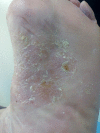Turicella otitidis as an Unusual Agent Causing Palmoplantar Eczema: An Emerging Pathogen
- PMID: 32133318
- PMCID: PMC7050971
- DOI: 10.12890/2020_001458
Turicella otitidis as an Unusual Agent Causing Palmoplantar Eczema: An Emerging Pathogen
Abstract
Introduction: Turicella otitidis, described as a new species over 20 years ago, has been isolated mainly from the external ear canal and middle ear fluid. Here, we report the first case of palmoplantar eczema related to T. otitidis.
Case presentation: Here, we report the first case of palmoplantar eczema in a 74-year-old female related to T. otitidis.
Conclusions: The question as to whether T. otitidis is a potential pathogen in cases of dyshidrotic eczema is still open, but this could be better elucidated if corynebacteria were speciated more often.
Learning points: The coryneform bacteria Turicella otitidis and Corynebacterium auris were recently detected for the first time in the middle ear of patients with acute otitis media and chronic otitis media.T. otitidis is a potential extraotic pathogen.T. otitidis may be implicated in the pathogenesis of palmoplantar dermatitis.
Keywords: Corynebacteria; Palmoplantar dermatitis; Turicella otitis; eczema.
© EFIM 2020.
Conflict of interest statement
Conflicts of Interests: The Authors declare that there are no competing interest
Figures
Similar articles
-
Metabolism and gene sequence variation in Turicella otitidis implies its adaptability and pathogenicity in extra-otic infection: a systematic review.BMC Infect Dis. 2023 Oct 27;23(1):735. doi: 10.1186/s12879-023-08721-y. BMC Infect Dis. 2023. PMID: 37891485 Free PMC article.
-
Turicella otitidis and Corynebacterium auris: 20 years on.Infection. 2014 Feb;42(1):1-4. doi: 10.1007/s15010-013-0488-x. Epub 2013 Jun 18. Infection. 2014. PMID: 23775360 Review.
-
Characterization, prognostic factors, and clinical profile of ear infections by Turicella otitidis: Revealing the emerging rise of a controversial pathogen.Am J Otolaryngol. 2025 Jan-Feb;46(1):104574. doi: 10.1016/j.amjoto.2024.104574. Epub 2024 Dec 19. Am J Otolaryngol. 2025. PMID: 39729793
-
Reviewing the Pathogenic Potential of the Otitis-Associated Bacteria Alloiococcus otitidis and Turicella otitidis.Front Cell Infect Microbiol. 2020 Feb 14;10:51. doi: 10.3389/fcimb.2020.00051. eCollection 2020. Front Cell Infect Microbiol. 2020. PMID: 32117817 Free PMC article. Review.
-
Post-intravitreal injection endophthalmitis secondary to Turicella otitidis: a case report.BMC Ophthalmol. 2020 Apr 10;20(1):142. doi: 10.1186/s12886-020-01412-1. BMC Ophthalmol. 2020. PMID: 32276621 Free PMC article.
Cited by
-
Turicella otitidis hypoglossal nerve stimulator device associated infection.IDCases. 2024 May 6;36:e01979. doi: 10.1016/j.idcr.2024.e01979. eCollection 2024. IDCases. 2024. PMID: 38765800 Free PMC article.
-
Turicella otitidis: a rare agent causing microbial keratitis.BMJ Case Rep. 2021 Jul 1;14(7):e241371. doi: 10.1136/bcr-2020-241371. BMJ Case Rep. 2021. PMID: 34210697 Free PMC article.
-
Metabolism and gene sequence variation in Turicella otitidis implies its adaptability and pathogenicity in extra-otic infection: a systematic review.BMC Infect Dis. 2023 Oct 27;23(1):735. doi: 10.1186/s12879-023-08721-y. BMC Infect Dis. 2023. PMID: 37891485 Free PMC article.
-
[Turicella otitidis isolates in otic exudates during 2020].Rev Esp Quimioter. 2021 Aug;34(4):390-392. doi: 10.37201/req/011.2021. Epub 2021 Jun 3. Rev Esp Quimioter. 2021. PMID: 34081421 Free PMC article. Spanish. No abstract available.
References
-
- Funke G, Stubbs S, Altwegg M, Carlotti A, Collins MD. Turicella otitidis gen. nov., sp. nov., a coryneform bacterium isolated from patients with otitis media. Int J Syst Bacteriol. 1994;44:270–273. - PubMed
-
- von Graevenitz A, Funke G. Turicella otitidis and Corynebacterium auris: 20 years on. Infection. 2014;42(1):1–4. - PubMed
-
- Jeziorski E, Marchandin H, Jean-Pierre H, Guyon G, Ludwig C, Lalande M, et al. [Turicella otitidis infection: otitis media complicated by mastoiditis]. Arch Pediatr. 2009;16(3):243–247. - PubMed
LinkOut - more resources
Full Text Sources

